A complete list of stationery for the school year. The main rules when choosing notebooks, pens and pencils. What to look for when buying a pencil case and accessories for creativity
There are only a few days left until the new school year. School fairs are already in full swing in the country. They can buy everything a child needs at school: from clothes and a backpack to pens and erasers. You can “rush” into such a fair with a list and buy the necessary supplies in one day. However, experts advise to split purchases into groups. So you will not be in a hurry, and you will definitely be able to choose a quality product. Today we will figure out how to get a good stationery - one that the child will use for a long time and with pleasure.
List of stationery for elementary grades
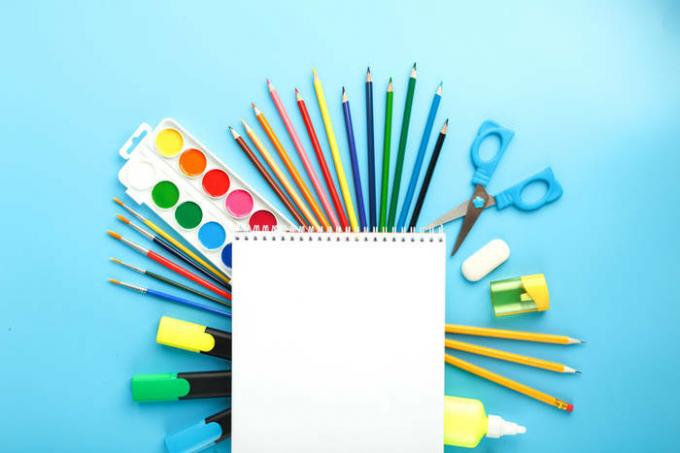
Before going to the stationery, it is better to make a list / istockphoto.com
Every experienced mother knows that you need to go to the store or to the bazaar with a list. Firstly, this way you will not forget anything. Secondly, you won't
spontaneous and unnecessary purchaseswhich are inevitable when you are choosing things for a child. The office is no exception here. Among the bright and colorful small things, it is easy to get confused, give in to a student's request and buy 10 fruit-shaped erasers and a set of fifty pens with colored ink.On the eve of the school year, at the first parent meeting, teachers give parents a list of necessary stationery. As a rule, for the lower grades, this list is practically the same. If you haven't been given such a hint yet, take note of:
- checkered notebooks, 12 sheets (2 pcs.)
- oblique notebooks, 12 sheets (2 pcs.)
- notebook covers (4 pcs.)
- diary (1 pc.)
- bookmarks
- folder for notebooks (A4 format)
- sketchbook, 12 sheets (1 pc.)
- set of cardboard (1 pack of white, 1 color)
- scissors (1 pc.)
- glue stick (1 pc.)
- simple pencils (2 pcs.)
- blue ballpoint pens (2 pcs.)
- colored pencils (1 set, 12 colors)
- sharpener (1 pc.)
- eraser (1 pc.)
- ruler 15-20 cm (1 pc.)
- plasticine (1 set, 8 colors)
- sculpting board and stacks (1 set)
- watercolor paints (1 set)
- gouache paints (1 set, 8-12 colors)
- brushes (3 pieces of different thickness)
- sippy glass
- apron with sleeves (for creativity)
Please note that in some positions this list is calculated for the minimum required number of items. For example, 2 pens, 2 pencils, a sharpener and an eraser are what a student must have in class. However, it is these accessories that have the mysterious property of being lost regularly. Therefore, you need to take at least a dozen pens and pencils, you need at least two sharpeners, and 3-4 erasers.
Notebooks and diary
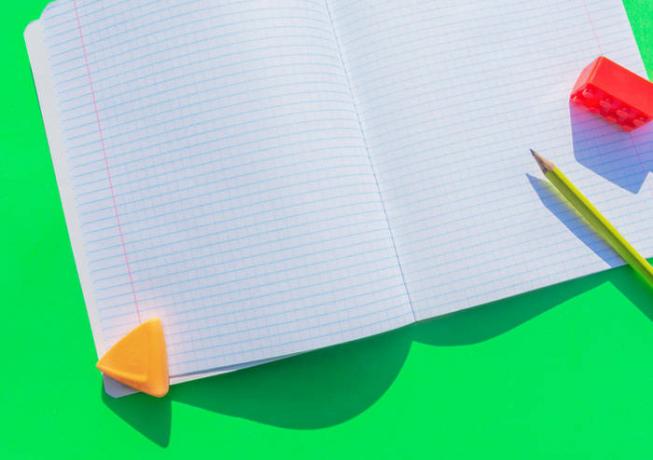
Ruling in terady should not "eat away" the eyes / istockphoto.com
Even in the first grade, a child should choose stationery. After all, it is for him, and not for you, to work with these accessories every day. However, the mother's task is to draw the baby's attention to the shelf with the “right” goods. For example, when it comes to choosing notebooks, a colorful cover with your favorite character is not the only purchase criterion.
- Pay attention to the cover: it should be dense enough and preferably with rounded corners. In elementary grades, children now write not so much, one notebook is enough for six months, so you need a dense cover to help keep the notebook neat
- The indoor unit should be made of white paper. The density of the sheets is also important here. While writing, children usually try and put a lot of pressure on the pen: it is necessary that the text is not retyped from one page of the notebook to another.
- The paper should be smooth to the touch, free from roughness and lint. This will allow the student to draw out the recipes more accurately, because the ink falls unevenly on the fleecy sheet.
- Lines and cells in notebooks should be drawn clearly, but not too brightly, so that the child does not ripple in the eyes. It is optimal when they are indicated in light blue. It is good if the ruled lines and margins in the notebook coincide on both sides - this is a sign of a quality product.
All recommendations for notebooks also apply to the choice diary. Your child's first school document will last for a whole year, so pay special attention to the cover. There is no need to buy a diary in a hard "book" cover - this option will be too heavy and voluminous, and will take up a lot of space in the folder. But the cardboard cover with lamination is just that.
Also pay attention to the design of the internal pages. In the lower grades, it should be standardized and coincide with the requirements of the teacher, because children are just learning to keep a diary. Explaining the rules for filling it out to the whole class is much easier if the ruling is approximately the same for everyone.
Pens

Grab medium-thick plastic pens for students / istockphoto.com
The choice of the handle directly depends correct grip while writing and the future handwriting of the child, so choosing such a primitive instrument is especially worthwhile. Experts advise paying attention to the following nuances:
The thickness and shape of the case. Pens that are too thin or thick are uncomfortable for a child, so choose a medium-thick writing instrument (6-7 mm in diameter). Triangular pens (triangular) are very convenient for teaching writing skills - they help to form the correct grip.
Body material. Plastic handles are best for children - they are strong enough and at the same time lightweight. You should not buy elite metal pens for elementary grades. The child will not appreciate the costs, and the hand while writing with such a pen will get tired more than with a plastic one.
Rubber grip. Many handles have a rubber grip in the grip area called a grip. Not only does it prevent fingers from slipping while writing. For children, such a nozzle plays the role of a simulator, teaching them to put their fingers at the right distance from the tip of the rod.
Line width. This preference, like the thickness of the line, is laid down in childhood: someone likes to write with a thin rod, while someone likes it to be "bold". However, keep in mind that the thick writing line is very often smeared, and unnecessary "dirt" appears in the notebook. For primary grades and teaching writing, the optimal line thickness is 0.5-0.7 mm.
Ink. The ink in an elementary school pen should be oily. It is inconvenient for a kid to write with helium pens, and besides, they often dry out. If the child wants, buy him some helium pens with colored ink - they are good for drawing and coloring during recess.
Pencils, sharpeners, erasers
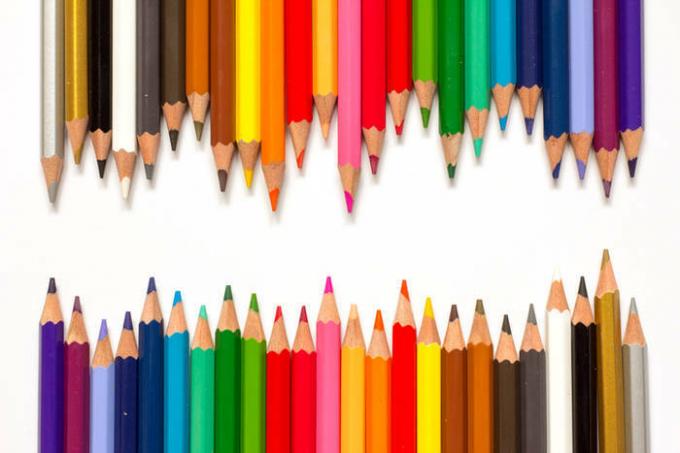
Pencils for drawing should be of medium hardness / istockphoto.com
The main criterion for choosing pencil for a child it is the hardness of the rod. Too hard will be inconvenient to draw, and too soft will be shaded on the paper. Therefore, choose a drawing tool of medium hardness, with TM or HB marking. Do not use pencils with an eraser. As a rule, it is of poor quality and leaves dirty streaks in the notebook. In addition, the metal fastener that holds this rubber band can tear and scratch the paper.
Exactly the same rule when choosing colored pencils - it is optimal if they are of medium hardness. But parents are not limited in the number of colors. There can be at least 12, at least 48. The only thing, keep in mind that the cardboard box in which the pencils lie will "live" for a very short time. Therefore, it is worth buying a special pencil case for storing and carrying them.
Qualitative eraser better to buy separately. It should be soft enough to the touch and preferably white or gray in color. Bright and colorful modern rubber bands in the form of everything you can think of are more suitable for playing during recess than for working with drawings. As a rule, during their intended use, they leave behind colored marks.
Also, the child really needs pencil sharpenerso that during the lesson he can sharpen the broken pencil on his own. Choose a tool with a container for shavings so that the debris does not fly to the floor and does not lie on the desk. However, please note that this container is tightly connected to the sharpener itself (preferably screwed on), otherwise it will be the first thing a child will lose in class.
Pencil case
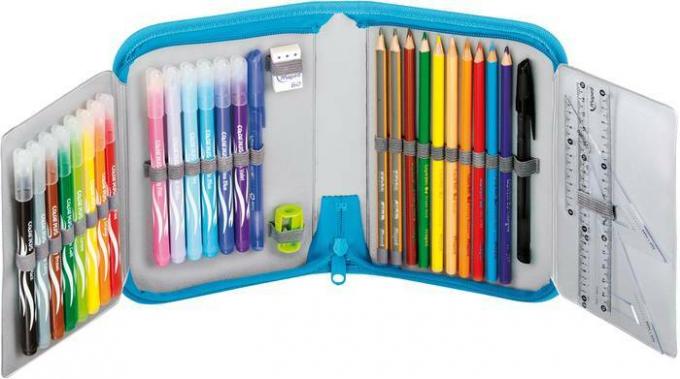
Convenient if everything is at hand in the child's pencil case / istockphoto.com
Whether your child needs to buy a pencil case depends on how your classroom will be organized. In some schools, younger students do not carry stationery home, but leave them in special boxes under a desk or in a school locker. Therefore, it may happen that an expensive purchase fails at your home unnecessarily.
If you still need a pencil case, you should not save on it. For kids, models with zippers are very convenient, which open like a book - so that all accessories are in sight and at hand. Most often, such pencil cases are made of synthetic fabric, which is easy to clean. However, please note that the inserts inside the case (which provide it with rigidity) are not made of cardboard, but of plastic or foam rubber. This way you can wash your pencil case without the fear that its frame will "get wet".
Art supplies
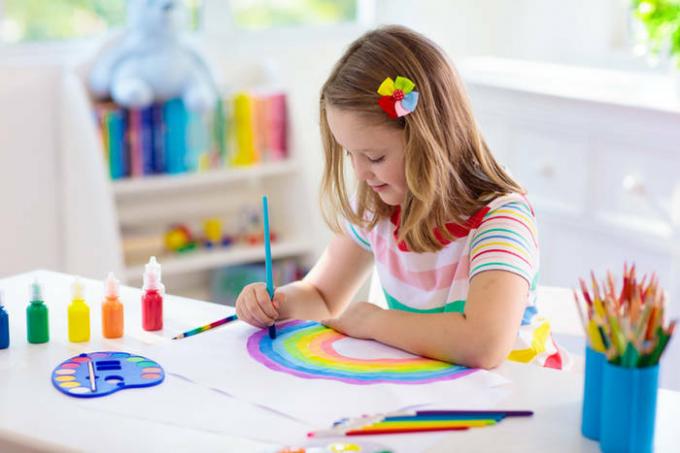
It is very easy for children to get dirty in creativity lessons / istockphoto.com
Here, the choice of parents is practically unlimited, but there are still some recommendations. So, for example, when choosing plasticine teachers are asked to pay attention to softness so that during class the child does not have to spend a lot of time warming up the material. Scissors for children must be with rounded ends and in a protective plastic case. And the liquid PVA glue in schools has long been changed to a practical and convenient glue stick.
For drawing with paints, it is very important to buy a child sippy cup, because carrying water to the desk during a drawing lesson is another challenge for a kid. For the same reason, many schools ask to buy special sets (apron and armbands) made of polyethylene for creativity lessons. They will save the child from getting dirty or splashing.
You will also be interested to read:
Backpack for a first grader: 10 rules for the perfect choice
First grade: how to organize a workplace for a student




